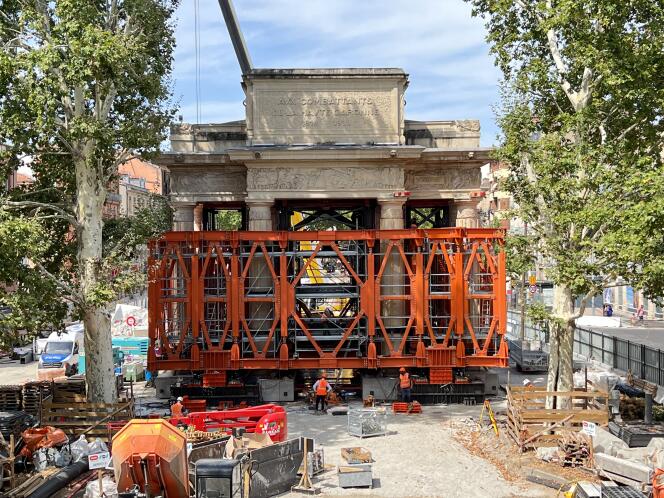


On Thursday, August 31, one of Toulouse's most emblematic features, a monument to the servicemen of the Haute-Garonne department, will begin a 33-meter move from its current site to its temporary storage location. This impressive triumphal arch – 17 meters long, 12 wide and 16 high and weighing 1,330 tonnes – will take three hours to move. This unusual relocation is necessary for the construction of the southern French city's third metro line, one of whose stations, François Verdier, will be located 35 meters below ground, directly under the arch.
Erected between 1923 and 1928, this arch was originally intended to pay tribute to all First World War servicemen from Haute-Garonne, dead or alive. However, many soon came to regard it as a monument to the dead, much to the chagrin of its designer, architect Léon Jaussely (1875-1932). Erected on the Allées Forain-François-Verdier, close to the historic center, it combines Art Deco style with ancient Roman architecture, notably in the sculptures by four local artists: André Abbal, Jean-Marie Fourès, Henri-Raphaël Moncassin and Camille Raynaud.
With the creation of the subway station threatening its integrity, the preservation of the monument was entrusted to Arc & Sites. Several potential plans were studied: maintaining the monument in situ on huge concrete piles, dismantling and reassembling it stone by stone or moving the structure. Some 20 experts, under the leadership of Arc & Sites, carried out complete surveys of the monument, scrutinized the construction site archives and conducted numerous investigations into its foundations, its state of conservation and its structures prospected with georadar. In the end, it was the third scenario that prevailed.
After approval and the analysis of over 300 plans and calculation notes, preparatory work began, including the removal of the four trophies, each weighing almost 7 tonnes. The greatest technical challenge involved the top of the monument, its attic, which is heavier than its base. It has been consolidated on the inside by a wooden framework and on the outside by a metal exoskeleton that corsets and holds it in suspension. As a final precaution, numerous sensors have been installed to monitor any deformations in real time.

Over the past few days, 16 jacks have raised the edifice to a height of 1.60 meters to enable nine modular platforms to be slid in underneath it, equipped with 228 wheels, which will ensure its transport. There's one final difficulty: On its way to its reception area, the monument will have to be rotated 90 degrees, without damaging the plane trees in the Allée.
You have 14.48% of this article left to read. The rest is for subscribers only.
